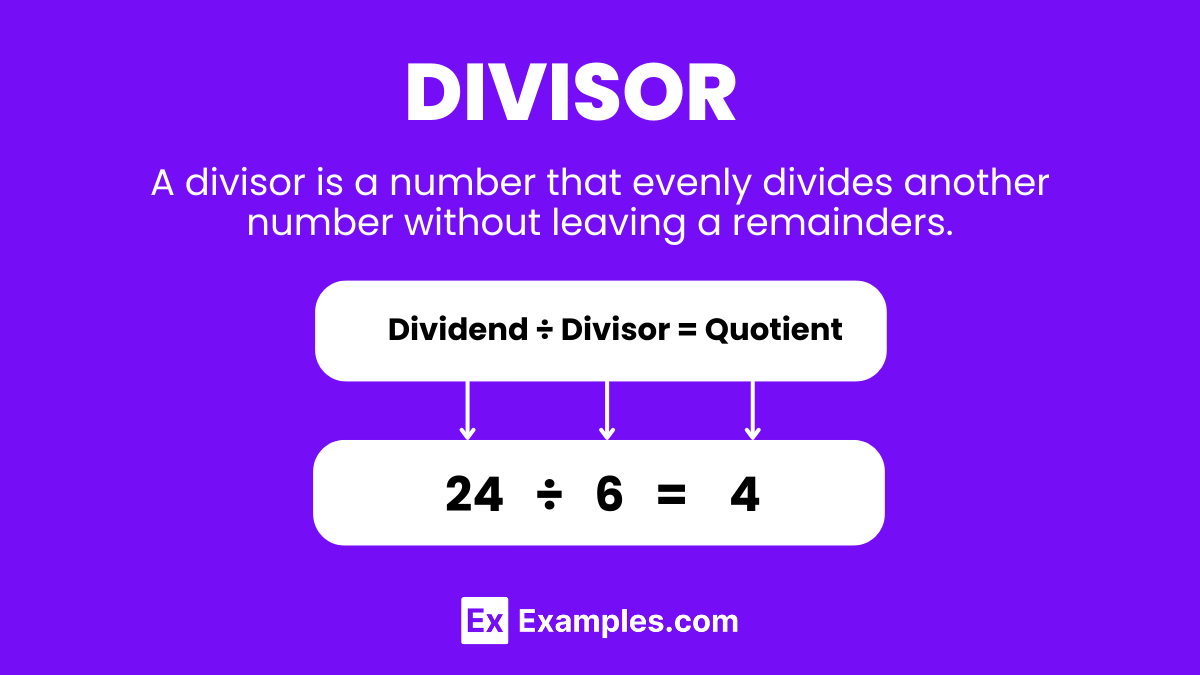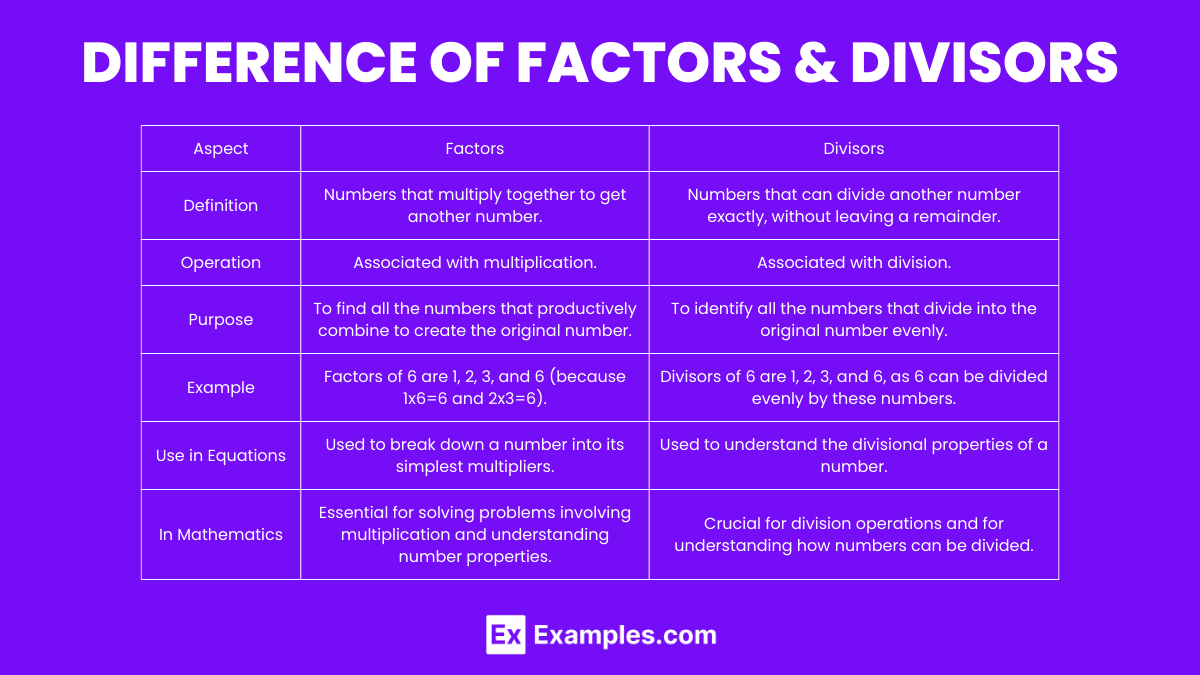How many divisors does the number 12 have?
4
5
6
7


The comprehensive guide on divisors, your essential resource for mastering mathematical concepts with ease. This section unravels the mystery of divisors through detailed examples and clear explanations, ensuring a deep understanding of how numbers relate and interact. From the basics of division to exploring prime and composite numbers, our guide enriches your mathematical knowledge, making complex ideas accessible. Whether you’re a student, educator, or math enthusiast, discover the fascinating world of divisors and enhance your numerical skills today.
A divisor is a number that can be divided into another number without leaving a remainder. In simple English, if you have two numbers and you can divide the first number by the second one completely (meaning it divides evenly), then the second number is called a divisor of the first number. For example, if you divide 10 by 2, the result is 5 with no remainder left over, making 2 a divisor of 10.
Finding divisors of a number involves identifying all the numbers that divide into it without leaving a remainder. Let’s go through the process with an example to make it clearer.
We can represent the divisor in three different ways;
Formula to find the Divisor: Dividend ÷ Divisor = Quotient
Given:
Divisor=30 ÷6=5
Let’s go through a few examples to understand what the dividend, divisor, and remainder are in each case.
lets’s take Division: 15 ÷ 4
Dividend: 15 (The number we are dividing)
Divisor: 4 (The number by which we divide)
Operation: When we divide 15 by 4, we get 3 as a quotient with a remainder.
Quotient: 3 (The whole number result of the division)
Remainder: 3 (Because 15−(4×3)=3)
lets’s take Division: 20 ÷ 3
Dividend: 20 (The number we are dividing)
Divisor: 3 (The number by which we divide)
Operation: Dividing 20 by 3 gives us a quotient with a remainder.
Quotient: 6 (The whole number result of the division)
Remainder: 2 (Because 20−(3×6)=2)
 When exploring the realm of mathematics, particularly division and multiplication, the terms “factors” and “divisors” often come up. Although they are closely related and sometimes used interchangeably, there are subtle differences worth noting. This comprehensive guide aims to clarify these differences in a structured manner, enhancing your understanding of these fundamental concepts.
When exploring the realm of mathematics, particularly division and multiplication, the terms “factors” and “divisors” often come up. Although they are closely related and sometimes used interchangeably, there are subtle differences worth noting. This comprehensive guide aims to clarify these differences in a structured manner, enhancing your understanding of these fundamental concepts.
Before diving into the differences, let’s establish a foundational understanding of each term:
| Aspect | Factors | Divisors |
|---|---|---|
| Definition | Numbers that multiply together to get another number. | Numbers that can divide another number exactly, without leaving a remainder. |
| Operation | Associated with multiplication. | Associated with division. |
| Purpose | To find all the numbers that productively combine to create the original number. | To identify all the numbers that divide into the original number evenly. |
| Example | Factors of 6 are 1, 2, 3, and 6 (because 1×6=6 and 2×3=6). | Divisors of 6 are 1, 2, 3, and 6, as 6 can be divided evenly by these numbers. |
| Use in Equations | Used to break down a number into its simplest multipliers. | Used to understand the divisional properties of a number. |
| In Mathematics | Essential for solving problems involving multiplication and understanding number properties. | Crucial for division operations and for understanding how numbers can be divided. |
| Interchangeability | While all factors of a number can be considered its divisors, the term is more specific to the multiplication context. | While all divisors can be considered factors, the term is more tailored to the division context. |
Diving into the realm of mathematics, the concept of divisors plays a pivotal role in understanding the structure and relationships between numbers. Divisors, by definition, are integers that can divide another integer exactly, leaving no remainder. This guide explores the essential properties of divisors, shedding light on their significance and application in various mathematical contexts. Let’s unravel the properties that make divisors a fundamental element in the study of numbers.
All divisors are integers. This means that for any two integers a and b, if b is a divisor of a, then the result of a÷ b is also an integer. This property underscores the discrete nature of divisors, distinguishing them from fractions or decimals.
Every non-zero integer is a divisor of itself, and every integer has at least two divisors: one and itself. This universal property highlights the inclusivity of divisors across the number spectrum, from negative integers to positive integers.
For every positive divisor of a number, there exists a corresponding negative divisor. If d is a divisor of n, then −d is also a divisor of n. This duality extends the concept of divisors beyond positive integers, embracing the complete integer set.
The relationship between divisors and multiples is reciprocal. If a is a divisor of b, then b is a multiple of a. This interconnection provides a framework for understanding how numbers interrelate through division and multiplication.
Divisors can be categorized into prime divisors, which are prime numbers, and composite divisors, which are composite numbers. This classification is crucial for factorization processes, where numbers are broken down into their prime divisors to simplify mathematical expressions or solve problems.
Certain divisibility rules help identify divisors of numbers, such as divisibility by 2 for even numbers, by 3 if the sum of digits is divisible by 3, and so on. These rules offer shortcuts to finding divisors without exhaustive division.
The Fundamental Theorem of Arithmetic states that every integer greater than 1 either is prime itself or can be factored into prime numbers, which are its prime divisors. This property ensures that the prime factorization of a number is unique, barring the order of factors.
To find all the divisors of 12, we look for numbers that can divide 12 without leaving a remainder.
Divisors of 12: 1, 2, 3, 4, 6, 12.
Now, let’s find all the divisors of 18.
Divisors of 18: 1, 2, 3, 6, 9, 18.
Let’s find all the divisors of 28.
Divisors of 28: 1, 2, 4, 7, 14, 28.
Finally, let’s find all the divisors of 15.
Divisors of 15: 1, 3, 5, 15.
Positive divisors are integral parts of understanding a number’s composition. These divisors are key in various mathematical applications such as factoring numbers, determining prime numbers, and calculating the greatest common divisors (GCD) between numbers.
Negative divisors extend the concept of divisibility into the realm of negative numbers, offering a complete understanding of a number’s divisibility. They mirror the properties of positive divisors but are negative in value.
In conclusion, understanding divisors is fundamental to mastering key mathematical concepts. By exploring the divisors of numbers, we uncover the intricate relationships and patterns within mathematics. This knowledge not only enhances our problem-solving skills but also deepens our appreciation for the discipline’s beauty and complexity. Embracing the study of divisors opens doors to a richer, more connected understanding of the mathematical world.
Text prompt
Add Tone
How to Find Divisors?
Properties of Divisors
How many divisors does the number 12 have?
4
5
6
7
What is the greatest divisor of 20, excluding 20 itself?
4
5
10
15
Which of the following numbers is a divisor of 30?
7
8
9
10
How many divisors does the number 7 have?
1
2
3
4
What is the smallest divisor of 18, excluding 1?
2
3
4
6
Which of the following numbers is not a divisor of 24?
3
4
5
6
How many divisors does the number 28 have?
4
5
6
7
Which of the following numbers is a divisor of 42?
7
98
9
10
What is the smallest divisor of 35, excluding 1?
3
5
7
9
What is the sum of the divisors of 12?
24
28
30
32
Before you leave, take our quick quiz to enhance your learning!

